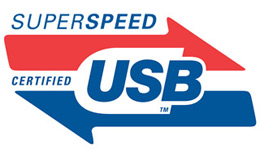USB 3.0
 USB
3.0 is the third generation of USB (Universal Series Bus) technology
that acts as a connector between a host computer and peripheral devices.
The name SuperSpeed comes from the higher data transfer rate which
greatly exceeds the previous standards of USB 1.1 and USB 2.0.
USB
3.0 is the third generation of USB (Universal Series Bus) technology
that acts as a connector between a host computer and peripheral devices.
The name SuperSpeed comes from the higher data transfer rate which
greatly exceeds the previous standards of USB 1.1 and USB 2.0.These external yet integral peripheral devices include but are not limited to: keyboards, monitors, printers, cameras, flash drives, gaming consoles and smartphones.
Like the earlier formats, it can link devices and computers without needing to first power down the computer. USB 3.0 is designed to not only streamline function of peripherals with PCs, but to do so with ten times the bandwidth. Developers at Intel announced the forthcoming release of USB 3.0 in 2007 with specifications and compatibility details underway in 2008 and 2009. The first devices equipped with USB 3.0 technology debuted in the commercial market in 2010.
SuperSpeed will likely not have complete mainstream operating system support until its developers at Intel release the motherboard chipset inherent to computer operation until 2012. It was originally slated for release more than a year earlier. However, it is speculated that competitors like AMD may attempt to integrate the USB 3.0 chipset into their technology a year ahead of Intel.
USB 3.0 SuperSpeed is designed to keep up with the pace of increased demands in consumer storage for more bandwidth for components including: high definition audio and video, increased megapixel data on cameras, smartphones with dozens of gigabytes of storage capacity and high-volume storage devices like Blu-ray drives. At USB 2.0’s optimum speed of 480 megabits per second, it may simply not meet the speed potential required by these devices.
In theory, the top speed throughput of USB 3.0 is 4.8 gigabits per second due to improved connectors and cables. Although it may not reach this transfer rate, just half of this transfer rate equates to the aforementioned bandwidth that is ten times faster than its predecessor. The USB 3.0 cable contains four extra wires compared to 2.0 to carry data information in a bidirectional manner. Considering it in terms of traffic, it simultaneously allows download and upload capabilities to travel through the cables without slowing due to data overload.
Power efficiency is another noted feature of USB 3.0. It can operate in three different modes to safeguard against excess energy use. Unlike USB 2.0—which had to continuously poll both active and idle devices for data information—the SuperSpeed interface signals the host computer or server for data transfer, therefore conserving power.
Users will be able to experience more power capabilities for configured devices as well as those not yet modified for setup. The Type B plug that enters into a device and the receptor carry an extra set of connectors to cut down on power demands for an item such as a wireless adapter. Consequently there is no reliance on a supplemental power source.
Backward compatibility is also possible with SuperSpeed. The actual connector maintains its dimension and form so that the additions of more internal wires to the design—which look like an extra metal fold—only need to be employed when linked to a 3.0 connection. As a result, USB 3.0 cables are incompatible with 2.0 devices, but USB 3.0 devices and cables are compatible with computers that have USB 2.0 ports.








